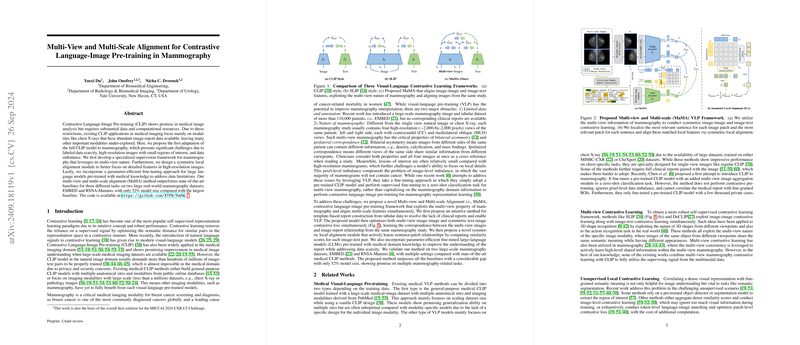Multi-View and Multi-Scale Alignment for Contrastive Language-Image Pre-training in Mammography
The paper "Multi-View and Multi-Scale Alignment for Contrastive Language-Image Pre-training in Mammography" presents a novel adaptation of the Contrastive Language-Image Pre-training (CLIP) model tailored for the domain of mammography. The authors address significant challenges in mammography such as the scarcity of labeled data, the high resolution of images, and the presence of imbalances both at the image and pixel levels. Given the lack of large, paired image-text datasets in mammography, the proposed approach introduces a specialized framework that utilizes multi-view mammographic data and a symmetric local alignment module to enhance the model's ability to focus on detailed features in high-resolution images.
Key Contributions
- Multi-View Supervision Framework: Recognizing the multi-view nature of mammography, the paper introduces a framework that leverages bilateral asymmetry and ipsilateral correspondence inherent to mammograms. This approach intents to align features from different views (craniocaudal and mediolateral oblique) from the same or opposite sides of a patient’s breasts to enhance feature learning under data constraints.
- Symmetric Local Alignment Module: This module is designed to focus on image-text coherence at a local level. By establishing a sentence-patch correspondence, it provides robust supervision for the mammographic domain where regions of interest (ROIs) are often minute and specific.
- Parameter-Efficient Fine-Tuning: The paper incorporates fine-tuning of pre-trained LLMs with medical knowledge to adapt them efficiently to mammography-specific datasets. This is done to address the limited availability of paired data and to optimize computational resources.
- Template-Based Report Construction: To circumvent the absence of standardized clinical reports in mammography datasets like EMBED and RSNA-Mammo, the authors develop a template-based method to construct reports from available tabular data.
Results and Insights
- Benchmark Performance: The proposed Multi-View and Multi-Scale Alignment (MaMA) outperforms state-of-the-art models on mammography datasets, achieving superior results with only 52% of the parameter size of the largest baseline models.
- Robustness to Data Scarcity: Through its innovative use of multi-view data alignment and efficient utilization of pre-trained LLMs, MaMA demonstrates significant improvements in classification tasks across varying amounts of fine-tuning data.
- Scalability and Efficiency: MaMA shows promise in maintaining classification performance while reducing computational costs, making it a potentially scalable approach for other modalities with similar data constraints.
Implications and Future Work
This adaptation of CLIP to the mammographic domain has several implications for future AI research and clinical application:
- Extension to Other Imaging Systems: The principles of multi-view and local alignment could potentially be applied to other high-resolution or multi-perspective imaging modalities, such as digital breast tomosynthesis or MRI.
- Clinical Integration: The model's ability to highlight and articulate image regions and associated diagnoses can facilitate more automated, efficient, and interpretable screening workflows in clinical settings.
- Broader Adoption of Pre-training in Medical Imaging: This research underscores the importance and potential of pre-training methods in specialized medical imaging contexts, encouraging further exploration into domain-specific model adaptation strategies.
Overall, this work adapts and extends the capabilities of CLIP into a domain with stringent data constraints and specific imaging characteristics, paving the way for more targeted and efficient applications of AI in medical diagnostics. Future developments could integrate this approach into broader multi-modal medical imaging frameworks, enhancing both processing efficiency and diagnostic accuracy.
